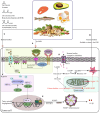Review of dietary patterns and gastric cancer risk: epidemiology and biological evidence
- PMID: 38444674
- PMCID: PMC10912593
- DOI: 10.3389/fonc.2024.1333623
Review of dietary patterns and gastric cancer risk: epidemiology and biological evidence
Abstract
Due to rapid research expansion on dietary factors and development of cancer prevention guidelines, the field of dietary pattern and its relationship to cancer risk has gained more focus. Numerous epidemiology studies have reported associations between Gastric Cancer (GC) and both data-driven posteriori dietary pattern and priori dietary pattern defined by predetermined dietary indexes. As dietary patterns have evolved, a series of patterns based on biological markers has advanced, offering deeper insights into the relationship between diet and the risk of cancer. Although researches on dietary patterns and cancer risk are booming, there is limited body of literature focusing specifically on GC. In this study, we compare the similarities and differences among the specific components of dietary patterns and indices, summarize current state of knowledge regarding dietary patterns related to GC and illustrate their potential mechanisms for GC prevention. In conclusion, we offer suggestions for future research based on the emerging themes within this rapidly evolving field.
Keywords: dietary patterns; gastric cancer; priori and posteriori; review; risk.
Copyright © 2024 Pu, Feng, Tang, Yang and Xu.
Conflict of interest statement
The authors declare that the research was conducted in the absence of any commercial or financial relationships that could be construed as a potential conflict of interest.
Figures




Similar articles
-
Dietary patterns and cancer risk.Nat Rev Cancer. 2020 Feb;20(2):125-138. doi: 10.1038/s41568-019-0227-4. Epub 2019 Dec 17. Nat Rev Cancer. 2020. PMID: 31848467 Review.
-
A Priori and a Posteriori Dietary Patterns among Pregnant Women in Johannesburg, South Africa: The NuPED Study.Nutrients. 2021 Feb 9;13(2):565. doi: 10.3390/nu13020565. Nutrients. 2021. PMID: 33572105 Free PMC article.
-
Dietary patterns in association to cancer incidence and survival: concept, current evidence, and suggestions for future research.Eur J Clin Nutr. 2018 Jun;72(6):818-825. doi: 10.1038/s41430-018-0128-8. Epub 2018 Mar 21. Eur J Clin Nutr. 2018. PMID: 29563640 Review.
-
A Healthy Asian A Posteriori Dietary Pattern Correlates with A Priori Dietary Patterns and Is Associated with Cardiovascular Disease Risk Factors in a Multiethnic Asian Population.J Nutr. 2018 Apr 1;148(4):616-623. doi: 10.1093/jn/nxy016. J Nutr. 2018. PMID: 29659965
-
Mediterranean Dietary Pattern is Associated with Lower Odds of Gastric Cancer: A Case-Control Study.Cancer Manag Res. 2022 Jun 17;14:2017-2029. doi: 10.2147/CMAR.S360468. eCollection 2022. Cancer Manag Res. 2022. PMID: 35747711 Free PMC article.
Cited by
-
Trends in Stomach Cancer Burden in China: A Joinpoint and APC Analysis Based on GBD 2021.J Gastroenterol Hepatol. 2025 Jun;40(6):1500-1514. doi: 10.1111/jgh.16956. Epub 2025 Apr 1. J Gastroenterol Hepatol. 2025. PMID: 40166947 Free PMC article.
-
Personalized Research on the Aging Face-A Narrative History.J Pers Med. 2024 Mar 26;14(4):343. doi: 10.3390/jpm14040343. J Pers Med. 2024. PMID: 38672970 Free PMC article. Review.
-
Predictive Mortality and Gastric Cancer Risk Using Clinical and Socio-Economic Data: A Nationwide Multicenter Cohort Study.Cancers (Basel). 2024 Dec 25;17(1):30. doi: 10.3390/cancers17010030. Cancers (Basel). 2024. PMID: 39796661 Free PMC article.
-
Epidemiology of Helicobacter pylori, gastric precancerous lesions and gastric cancer: a multicenter, population-based cross-sectional study in Nanjing.BMC Infect Dis. 2025 May 27;25(1):766. doi: 10.1186/s12879-025-11147-3. BMC Infect Dis. 2025. PMID: 40426075 Free PMC article.
-
High Sugar-Sweetened Beverage Intake and Oral Cavity Cancer in Smoking and Nonsmoking Women.JAMA Otolaryngol Head Neck Surg. 2025 May 1;151(5):450-457. doi: 10.1001/jamaoto.2024.5252. JAMA Otolaryngol Head Neck Surg. 2025. PMID: 40079983
References
Publication types
LinkOut - more resources
Full Text Sources
Research Materials
Miscellaneous

